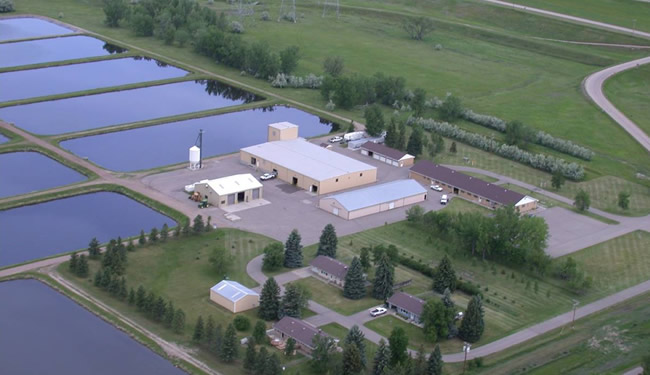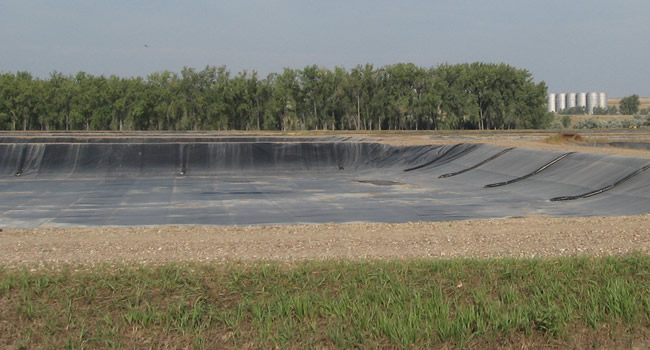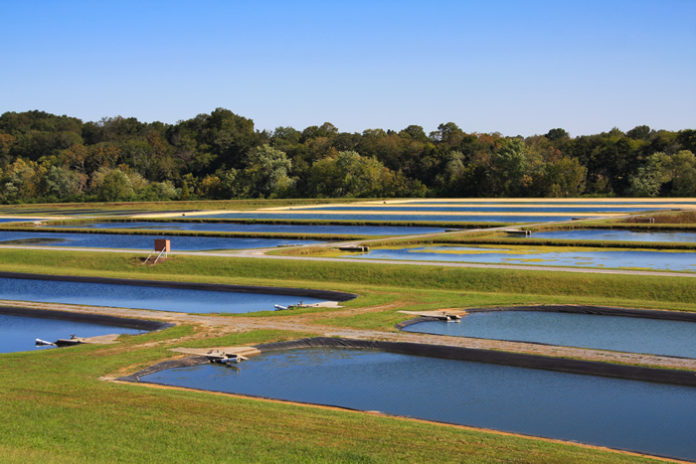Recently, we looked at the promise of geosynthetics in aquaculture operations, with AGRU having published a podcast on the subject. We also looked at a previous story on Geosynthetica about a Norwegian salmon operation and hatchery that had used one of the company’s lining solutions.
This led us back to the archives from Geosynthetica Senior Editor Chris Kelsey, who visited the Garrison Dam National Fish Hatchery a decade ago to meet with the site manager and discuss how geosynthetics improve hatchery production.
IMPROVING FISH HATCHERY OPERATIONS
Located an hour north of Bismarck, North Dakota on Lake Sakakawea, the Garrison hatchery is an important fish production center for the Midwest. The hatchery production is overseen by the US Fish and Wildlife Service (FWS) and supports 13 species of fish from popular northern varieties such as walleye, northern pike, and Chinook salmon to endangered species such as the pallid sturgeon.
The full Garrison Dam hatchery encompasses more than 200 acres and has 64 rearing ponds. The majority of those ponds are state ponds, with production focused towards the needs of state and North Dakota-based tribal waters, though partial funding and management of those ponds is provided by the FWS. The hatchery’s West Array is entirely federal. Twenty-four ponds are located in this sector, and in September 2009, the last of these 24 ponds were lined with geomembrane to improve operational performance and fish health.

The lining of the federal ponds was part of a steadily enacted plan going back to 2002, with up to four ponds being handled each year. In 2009, the availability of Recovery Act funds allowed the Garrison Dam NFH to line the West zone’s remaining 9 ponds.
IMPROVING HATCHERY PRODUCTION
The hatchery was established in 1957. Clay liners were used in the cells at the outset and for many years were very effective. But over 40+ years of operation, the clay liners broke down and exposed the native sandy soils beneath. This led to increasing seepage loss—up to 250,000 gallons per day from a single pond—which demanded more water input by the hatchery to sustain necessary water levels.
Also, vegetation took root. Vegetation can be problematic for hatchery production because it gives fish something to hide in or get trapped behind when ponds are to be drained.
Furthermore, the unlined pond beds were susceptible to clam shrimp, a native inhabitant of clay-bottom ponds in this part of North Dakota. These planktivorous shrimp live and dig in the clay, feed, lay eggs. They create dirtier, more turbid water. The tiny shrimp can number in the hundreds of thousands across a pond production array.
That was the case at Garrison Dam, where the shrimp-related turbidity in the old clay-lined ponds had reduced light penetration to the point that fish production and survival rates were hampered.
Clam shrimp could also get caught in the screens used to keep them out of the effluent channels through which harvested fish were drawn when ponds were drained. Screen breakages occurred when too many clam shrimp amassed on the screens. These events led on multiple occasions to a total loss in fish production from those ponds.

REPLACING CLAY WITH GEOSYNTHETIC LINERS
Geosynthetic pond lining has done much more for the Garrison Dam site than simply address the turbidity and clam shrimp problems that had developed in the eroding clay liners. Production yields have gone up a tremendous amount with the use of geomembranes.
In 2002, a first pond was lined with geomembrane as a pilot project. Walleye production in that pond increased by 13 times over the previous year. The size of the walleye from the lined pond was roughly double that of the walleye produced in unlined ponds.
Making it all the more remarkable was that during rearing the walleye spent only 30 days in the outdoor ponds. The health benefits realized for the fish in the geomembrane-lined cell was a remarkable return.
The success of the pilot project led to more ponds being approved for new lining systems, as funding became available.
For the Garrison Dam facility, the advantages in using geomembranes instead of clay were many. Among them:
- Water conservation. The impermeable geomembrane systems halted the high rate of seepage loss (250,000 gpd) that had been documented in the worst of the old ponds
- Cleaner water, more light. In lining the ponds, the hatchery has deprived the disruptive clam shrimp of their clay bottom habitat. The turbidity issue was corrected and the young fish thrived.
- Warmth. The use of a black geomembrane better retained warmth from the sun. The slightly warmer ponds more successfully stimulated the food chain and fish production, according the hatchery staff.
- No vegetation concerns. Treating unwanted vegetation in the past meant the application of herbicides. With the geomembrane liners, herbicides were no longer needed. It was a greener production process. Also, since the fish might grow to an inch and a half long by harvest, vegetation long-presented the risk of trapping fish during pond drawn down. With the smooth liner in place, a greater yield was realized.
- Safer harvest. Without the clam shrimp and the threat of clogged and breaking screens, harvesting the fish is a safer, more efficient, and more productive operation.
LINING GARRISON DAM NATIONAL FISH HATCHERY
Twenty-three of the 24 ponds at Garrison Dam NFH’s West Array were lined with 45-mil polypropylene geomembrane. The other was lined with a chlorosulfonated polyethylene (CSPE) geomembrane.
(EDITOR’S NOTE: All geomembranes on site were manufactured by Dow Geomembranes, though since publication of this article Dow has exited the geomembranes business in the United States.)

Polypropylene was chosen for the fish hatchery’s pond liners. It offered a chemically inert polymer which did not contain any post-reactor modifiers that could leach over time and have a negative impact on water quality and fish health. Also, the polypropylene formulation possessed outstanding dimensional stability, a low coefficient of expansion and contraction (which was essential for these exposed, northern ponds), a wide temperature seaming range to meet site-specific needs, and good chemical resistance. In addition, the polypropylene did not have the stress crack risk associated with more crystalline polymer constructions, and the flexibility of the membrane offered valuable lay-flat characteristics and tautness.
Further, the geomembrane had excellent UV resistance. Fish hatcheries, by the nature of their operations, must be flexible with production in order to best serve the ecosystems into which the fish they raise are stocked. Because of this, ponds may be taken out of use frequently and are, thus, even more exposed. Any geomembrane used in the hatchery’s outdoor rearing ponds had to be able to perform in an exposed environment.
In 2009, the last nine clay-bottom ponds in the West Array were lined with the help of a $920,000 grant from the Recovery Act. Eight of the ponds required roughly 90,000 sq. ft. each of the flexible polypropylene geomembrane. The ninth pond was a bit larger.
Installation was not without challenge.
North Dakota, in general, is a windy state; and the open space around the Garrison facility certainly invites wind.
The installed geomembrane rolls needed to be secured against wind uplift until each cell was finished. Where panel seaming or appurtenance welding was needed, the site crew had to take extra care prevent dirt, pebbles, and fish food from blowing into the in-process welds.
Integra Plastics performed the installation works. (Editor’s note: Integra was acquired by Raven Industries in 2014.)
To help make the work safer and more economical, Integra prefabricated most of the flexible polypropylene panels. The factory seams were guaranteed to be clean of wind-blown debris and installation was faster with fewer field seams to make.
Each prefabricated roll shipped to the site contained a 12-panel accordion bundled. The 45-mil polypropylene panels were joined by fusion welding at a temperature of approximately 700 F. Seams were conducted at a rate of 8 – 9 feet per minute. Two support crew members helped guarantee the cleanliness of the seams ahead of the operator.
Also of note during installation at Garrison, it was imperative that the lined fish hatchery ponds had flat, or taut, surfaces. If wrinkles were left in the lining system, the young fish might get caught against one during pond draining, just as vegetation could trap fish. To help ensure tautness, the crew anchored the installed polypropylene panels with sandbags and let the geomembrane sit in the sun until the air temperature reached at least 70° degrees before final welding occurred. The slight expansion that occurred in the black material as it warmed in the sun allowed the site crew to make the geomembrane as flat as possible.
Though some small wrinkles may eventually emerge due to annual freeze-thaw cycles, the patience and care during the West Array’s liner installation—matching work strategies to the site’s unique environmental characteristics—has had a beneficial impact on production.
The hatchery operator reported that up to two million additional walleye were now able produced at Garrison with the geosynthetic lining systems in place.
Some small repairs have been needed, but they have been almost exclusively tiny puncture damage near the top of the slopes. These easy-to-patch issues have been the result of animal traffic, the odd case of vandalism, or general operations (e.g., dropped equipment or small vehicle inadvertently driven onto exposed edge of a liner).
Overall, the Garrison site has been well-cared for. With the enhanced hatchery production, the impact of Garrison Dam NFH’s work can be found in the fish stocks of lakes and streams well-beyond Lake Sakakawea.












